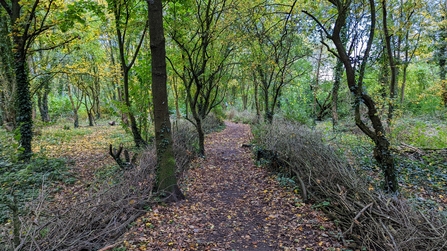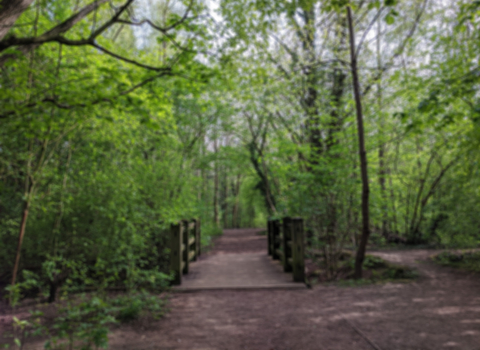Cock Robin Wood is a small urban woodland in Rugby that was planted on farmland in around 1990. As the woodland was largely planted in one go, the trees that made up the woodland were of a similar age. Additionally, many of the trees that had grown in the woodland were common ash trees which are highly susceptible to the recent outbreak of the disease ash dieback, which threatens to kill the majority of ash trees in the UK.
With the majority of the woodland being unmanaged since the 1990s, the trees grew up crowded and as they matured they began to block out light to the woodland floor. This meant young trees couldn’t grow, and mature trees were stressed due to overcrowding, limiting the lifespan of the woodland. It also meant that wildflowers and grasses would struggle to grow without adequate light.
The wood before work started, with little variation in growth and a shaded woodland floor
In 2018, Warwickshire Wildlife Trust began a project to thin out the entire woodland over five years. The project aims to diversify the structure of the woodland and encourage younger trees and woodland vegetation to establish. The increased diversity in the woodland would provide a greater range of habitats for wildlife, increasing the biodiversity potential of the nature reserve. It would also reduce competition for remaining trees, meaning a healthier woodland and allowing older ‘veteran’ trees to establish over the coming decades and provide increased wildlife value.
The woodland was thinned by removing around 30% of the trees, with more thinning on path edges to provide light to open spaces for vegetation. Where present, ash was removed as a priority to reduce the health and safety risk of falling trees, and to give space to trees more likely to continue to grow on. The thinning focused on retaining trees of good form or high wildlife value, and on retaining a good mix of tree species. Trees covered in ivy were kept for their value as bat roosts and a late nectar source for pollinators. The management was spread out over five years so that disturbance didn’t cover the whole woodland, and existing wildlife could move to other parts of the reserve in response to the changes being made.
Since thinning began, the woodland has shown positive signs of recovery with new and coppiced trees regenerating into a nice thick ‘understorey’. This means that the area between the canopy and the soil is no longer a dead zone and there is more habitat for wildlife to nest and forage and seek cover in. Additionally, there are plenty of new ash trees growing which are being left in case of genetic resistance to ash dieback. If they are not resistant they will not reach a size where they can become a health and safety concern, but if they are resistant they will be able to spread their genetic resistance in their seed once they grow large enough.

Cock Robin Wood after woodland management, by Nicholas Feledziak





